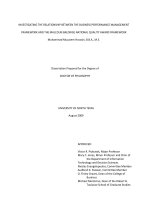Lecture Performance management: Session 18 - Osman Bin Saif
Bạn đang xem bản rút gọn của tài liệu. Xem và tải ngay bản đầy đủ của tài liệu tại đây (437.23 KB, 36 trang )
LECTURE:
EIGHTEEN
HRM-755
PERFORMANCE
MANAGEMENT
OSMAN BIN SAIF
1
Summary of Previous Lecture
•
Training Programs Coverage
•
End of Chapter Case study Practice
•
CHAPTER 7
IMPLEMENTING A PERFORMANCE
MANAGEMENT SYSTEM
•
Preparation process for Implementation
•
Communication Plan
•
Good Communication Plan
2
Agenda of Today’s Lecture
•
Communication Plan
•
Good Communication Plan
•
Communication Bias
•
Types of Bias
•
–
Selective Exposure
–
Selective Perception
–
Selective Retention
Ways to minimize negative impact
of
3
Communication plan
•
•
Having more and better knowledge of
performance management system leads
to greater employee acceptance and
satisfaction.
Organizations often design a
communication plan to ensure that
information regarding the performance
management system is widely
disseminated in the organization.4
Good Communication Plan
A good communication plan answers the
following questions:
•
What is performance management?
–
Answering this question involves providing
general information about performance
management, how performance management
systems are implemented in other
organizations, and the general goal of
performance management systems.
5
Good Communication Plan
(Contd.)
•
How does performance management fit
into our strategy?
–
To answer this question, we should provide
information on the relationship between
performance management and strategic
planning. Information is provided on how the
performance management system will help
accomplish strategic goals.
6
Good Communication Plan
(Contd.)
•
What’s in it for me?
–
A good communication plan describes the
benefit of implementing performance
management for all those involved.
7
Good Communication Plan
(Contd.)
•
How does it work?
–
Answering this question entails giving a
detailed description of performance
management process and time line: for
example, when meetings will take place, what
the purpose of each meeting are, and when
decisions about rewards will be made
.
8
Good Communication Plan
(Contd.)
•
What are my responsibilities?
–
The communication plan should include
information on the role and responsibilities of
each person involved at each stage of
process.
–
For example, it includes a description of the
employees and supervisors main
responsibilities in the performance
management process.
9
Good Communication Plan
(Contd.)
•
How is performance management related
to other initiatives?
–
The communication plan should information
on the relationship between performance
management and systems, such as training,
promotion, and succession planning.
10
11
12
13
Good Communication Plan
(Contd.)
•
In summary the communication plan
implemented by the Department of Justice
is extremely detailed and provides
answers to most , if not all of the key
questions that should be addressed by a
good communication plan.
14
Communication Bias
•
However, even if a communication plan
answers all or most of the important
questions, the fact that the information has
been made available does not necessarily
mean the communication plan will be
successful in gaining acceptance.
15
Communication Bias (Contd.)
•
This is because people have cognitive
biases that affect what information is taken
in and how it is processed.
16
Communication Bias (Contd.)
•
•
Specifically there are three types of biases
that affect the effectiveness of a
communication plan, regardless of how
well it has been implemented.
These are;
–
Selective Exposure
–
Selective Perception
–
Selective Retention
17
Selective Exposure
•
•
It is a tendency to expose our minds only
to ideas with which we already agree.
Those employees who already agree that
performance management is a good idea
may become involved in the
communication plan activities including
reading about the system and attending
meetings describing how the system
18
works.
Selective Exposure (Contd.)
•
On the other hand, those who do not see
much value in performance management
may choose not to read information about
it and put not to attend meetings related to
performance management.
19
Selective Perception
•
Second, selective perception is a
tendency to perceive a piece of
information as meaning what we would
like it to mean even though the information
as intended by the communicator, may
mean the exact opposite.
20
Selective Perception (Contd.)
•
Someone who believes performance
management is about only rewards and
punishment may incorrectly interpret that
receiving a pay increase or bonus.
21
Selective Retention
•
•
Third selective retention is a tendency to
remember only those pieces of information
with which we already agree.
If an employee perceives his employer as
vindictive, that employee is not likely to
remember information about how the
appeals process works or about other fair
and equitable aspects of the system.
22
Selective Retention (Contd.)
•
Selective Exposure, Selective Perception,
Selective Retention biases are pervasive
and could easily render the
communication plan ineffective.
23
Ways to minimize negative
impact of Biases
There are several ways to minimize the
negative impact of these biases and
therefore, help gain support for the system.
•
Involve employees:
–
Involve employee in the design of the system.
People support what they create.
–
The higher the level of participation is in
designing the system, the greater the support
24
Ways to minimize negative
impact of Biases (Contd.)
•
Understand employee needs:
–
Understand the needs of employees and
identify ways in which these needs can be
met through performance management.
25









